Without realizing it, you’ve seen all kinds of Google Ads over the past twenty years. You may have come across a fasting app while reading about weight loss. Or you may be looking for sneakers and found a deal on a pair in the Google search results. These ads were from Google! While Google Ads may appear complicated at first, as with anything that seems difficult, Google advertising becomes much simpler once the process is understood. That is what we are doing in this article. Google Ads, formerly known as Google AdWords, is a marketing tool the company developed that enables users to promote their companies by placing advertisements on Google search results and throughout its network. This pay-per-click (PPC) advertising solution lets advertisers pay per click or impression.
Five different kinds of Google Ads advertising campaigns:
- Search (text ads on Google search results);
- Display (image ads on websites);
- Video (video ads on YouTube);
- Shopping (product listings on Google);
- App (promotion of your app through various channels).
1. Google search ads
It can help you draw in potential customers. On the pages of the Google search engine results, there are text ads called Google search ads (SERPs). Your search ads may show up either at the very bottom of the page or at the top above the organic search results.
It is used to get in front of potential customers. You can reach customers looking for the goods and services you provide by targeting keywords with buyer intent. For instance, you can draw in customers looking to buy dog beds by targeting keywords like “dog beds cheap” in your Shopify store. Your bid price determines whether your ad campaign appears at the top or bottom of the SERPs. The higher your bid, the more visible you become guidelines for Google search ads.
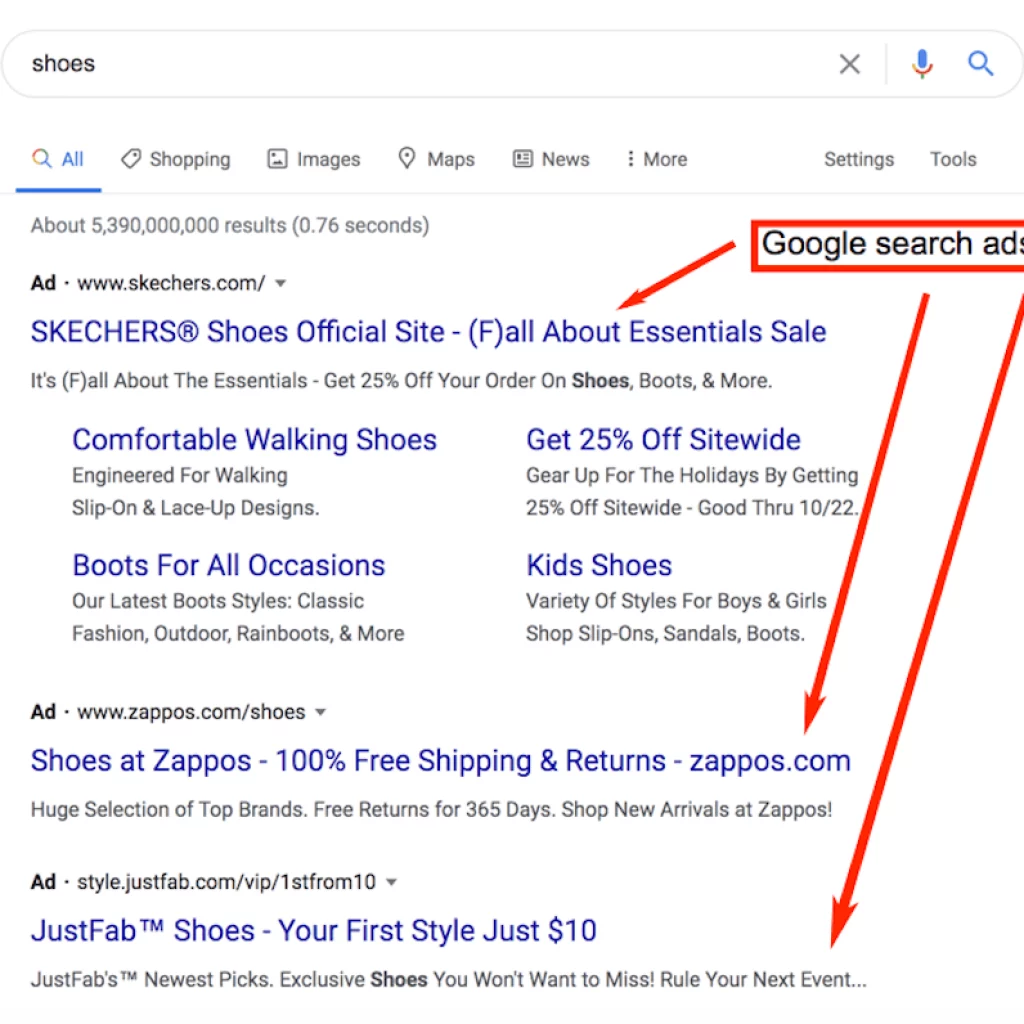
Here is a list of Google search ad best practices that will assist you in increasing sales.
- Write compelling ad copy.
Remember that your writing skills will determine their effectiveness since search ads are just text with no accompanying images. Your ad copy should concentrate on user benefits rather than product features. Appeal to the needs and feelings of your potential customers. Additionally, since there is little room in your advertisement, highlight only the most crucial details. Use specific calls to action rather than general phrases.
- Establish branded search campaigns.
If your company is new and you still need to rank organically, it is advised that you bid on your branded terms. By doing this, you can guarantee that potential clients will be able to find you easily if they want to check you out. Run a branded search ad even if you already have a high organic ranking on Google; it will still be helpful. Grammarly does it despite having a strong, well-recognized brand. You take up much more room on the SERPs and improve your chances of getting traffic by placing a bid on your brand name. Think wisely, just like Grammarly!
- Search campaigns for rival websites.
Targeting the branded terms of your rivals is another way to use text advertisements. It’s perfectly acceptable to do; it’s a widely used technique. Take advantage of this opportunity to boost your sales because it’s likely that people looking for your competitors’ products will also be interested in yours. Additionally, if you’re already well-known in your industry, your rivals are likely competing for your branded terms.
- Publish dynamic search ads
Google claims that every day, 15% of searches are for the first time. While this increases the number of ways savvy marketers can reach their target audience, staying on top of all the pertinent keywords for your brand is more challenging. Run dynamic search ads to save time and make managing keyword lists simpler. They provide the simplest means of connecting with people looking for your goods and services on Google. Dynamic search ads target users based on the content of your online store.
- Publish responsive search ads.
Although they may have a similar sound, responsive and dynamic search ads differ. With dynamic ads, your ads are created by automatically adjusting content pulled from the website. In contrast, the advertiser for responsive ads must create a list of various ad headlines and descriptions for the same ad. Then, Google Ads automatically combines and contrasts them to identify the combinations that perform the best and can enhance the performance of your campaign by using responsive search ads to determine the best way to match users’ search intent. Additionally, they help you reach more people and let you customize your ad text based on the locations of your customers.
2. Display ads: build brand recognition
Display ads are image-based and allow you to target people interested in your products but aren’t actively looking for them, whereas search ads are text-based and target specific keywords. Here is an illustration of a display ad: When you browse your favourite websites, display campaigns are frequently visible. However, they might also appear in videos, apps, or your Gmail account.
It is best in reaching out to potential customers early in the purchasing process to raise brand awareness.
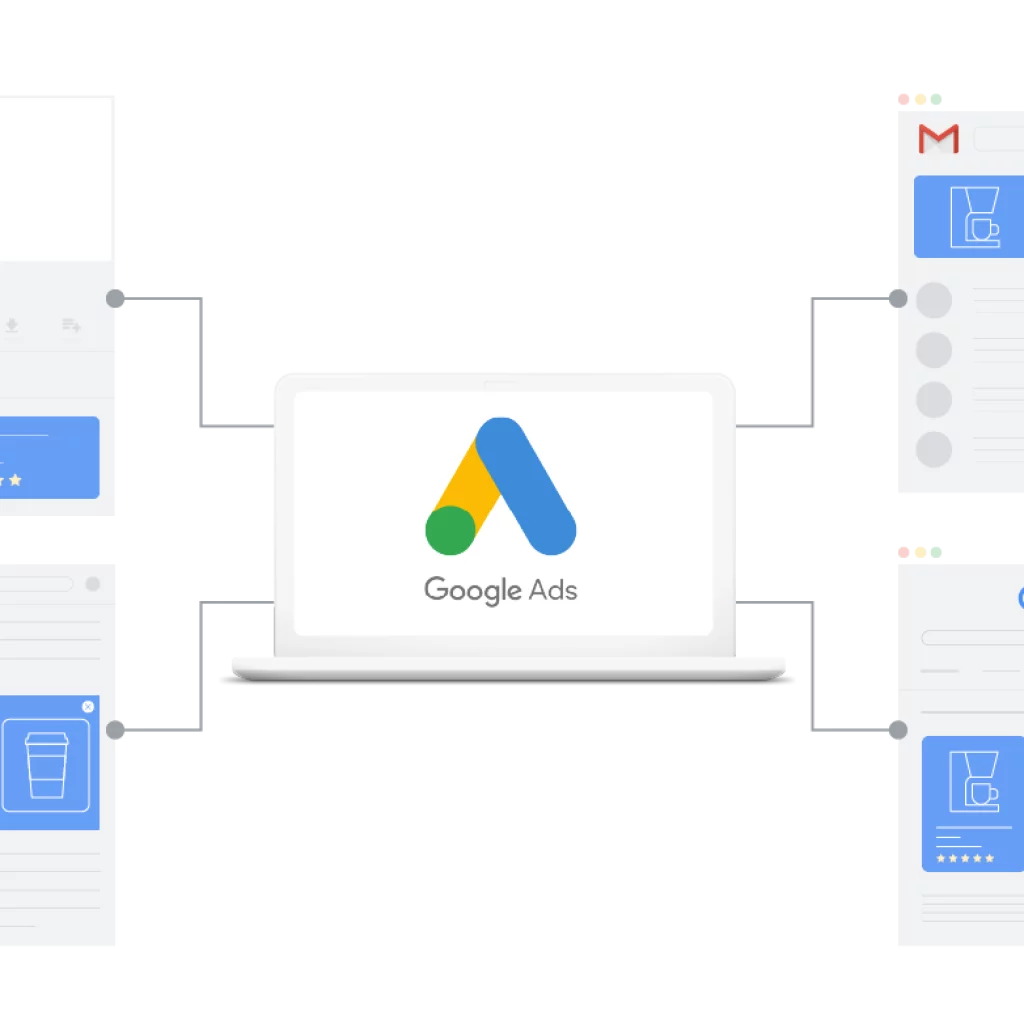
You can use display ads to introduce your company to niche target markets that are likely to be interested in what you have to offer. You can reach more people by doing so than by relying solely on search ads. Here’s another excellent display advertisement that gets right to the point:
Display Network by Google
Google uses the Google Display Network to show your campaigns to interested parties (GDN). Your Google Ads may appear on a network of more than 2 million websites, apps, and videos. Based on the characteristics of your target market, such as their age, gender, or interests, you can choose where or when you want your advertisements to be displayed. You can connect with more than 90% of internet users worldwide using Google Display Network.
Guidelines for Google Display Ads
Here is a list of Google Display ad best practices that will assist you in building brand awareness and attracting more customers to your sales funnel.
- Give responsive display ads top priority.
Three different display ads are available: responsive, Gmail, and uploaded image ads. While all three ad formats are helpful and can support various marketing strategies, responsive display ads, according to Google, have the greatest reach. We advise allocating more funding to them because of this. The format, size, and appearance of responsive display ads are automatically adjusted to fit all available Google Display Network placements. Upload your assets, such as pictures, headlines, descriptions, your logo, or videos, and Google will choose the most effective way to combine them to create your ads.
- Do not combine remarketing audiences with new users.
Remarketing is made possible by display ads, and it’s a great way to remind website visitors about your products. However, be sure to exclude anyone who has already visited your online store or viewed one of your YouTube videos from your new audiences. They will likely require a different type of messaging than those who have never heard of you because they are already familiar with your brand.
- Draw in similar demographics to your valuable visitors.
You can increase the number of people in your top-of-the-funnel audiences (those who are still unaware of you) by using the remarketing audiences created by your previous visitors. You can use your high-value visitors to identify individuals who are like them and are most likely to become your clients. Use the “Similar Audiences” targeting option to accomplish this. It enables you to reach out to potential customers who use the web in a way comparable to those from your remarketing campaign.
3. Video Ads get in front of a targeted audience.
Because YouTube is a part of Google and functions similarly to a search engine, but only for videos, you can target potential customers on the platform based on what they are watching. Additionally, you have a sizable audience to target, with more than 2 billion users worldwide. Video ad campaigns display search results.
Video ads can be used to reach the right audience with your product or service.

You can use demographic targeting with video ads to find your target audiences by age, gender, and interests. Before viewers can skip to their intended video or watch the entire ad, there is a 5-second countdown on in-stream video ads. In either scenario, you have plenty of time to communicate your point. Use this ad format in conjunction with display advertising for the greatest impact.
Guidelines for Google Video Ads
Here is a list of Google Ads’ recommended best practices for running video ads that will help you increase brand recognition and generate more leads.
- Narrow your audience.
Keep in mind that if you advertise to everyone, nobody will see it. Create distinct video ads targeting particular keywords, topics, or demographics to run effective ad campaigns. In this way, your target audiences will see ads that are relevant to them and are more likely to enter your marketing funnel.
- Your advertisement brief
Deliver your most important messages early in the video because ad play rates start to decline after 45 seconds.
- Utilize campaign settings in advance.
Utilize sophisticated campaign settings to optimize your video ads. For instance, you can programme your ads on specific days or times of the week when your target audience is most likely to see them. To prevent ad fatigue, you can also set a frequency cap to restrict how frequently your ads appear on YouTube or with partners on the Google Display Network.
4. Google Shopping Ads.
Shopping ads target shopper-ready consumers. Product-based ads. Google product searches specifically display these ads. However, unlike standard search ads, shopping ads show a product image with its title, price, store name, and reviews. Essentially, they give customers crucial product details before visiting an online store.
They can increase sales and traffic to your online store.
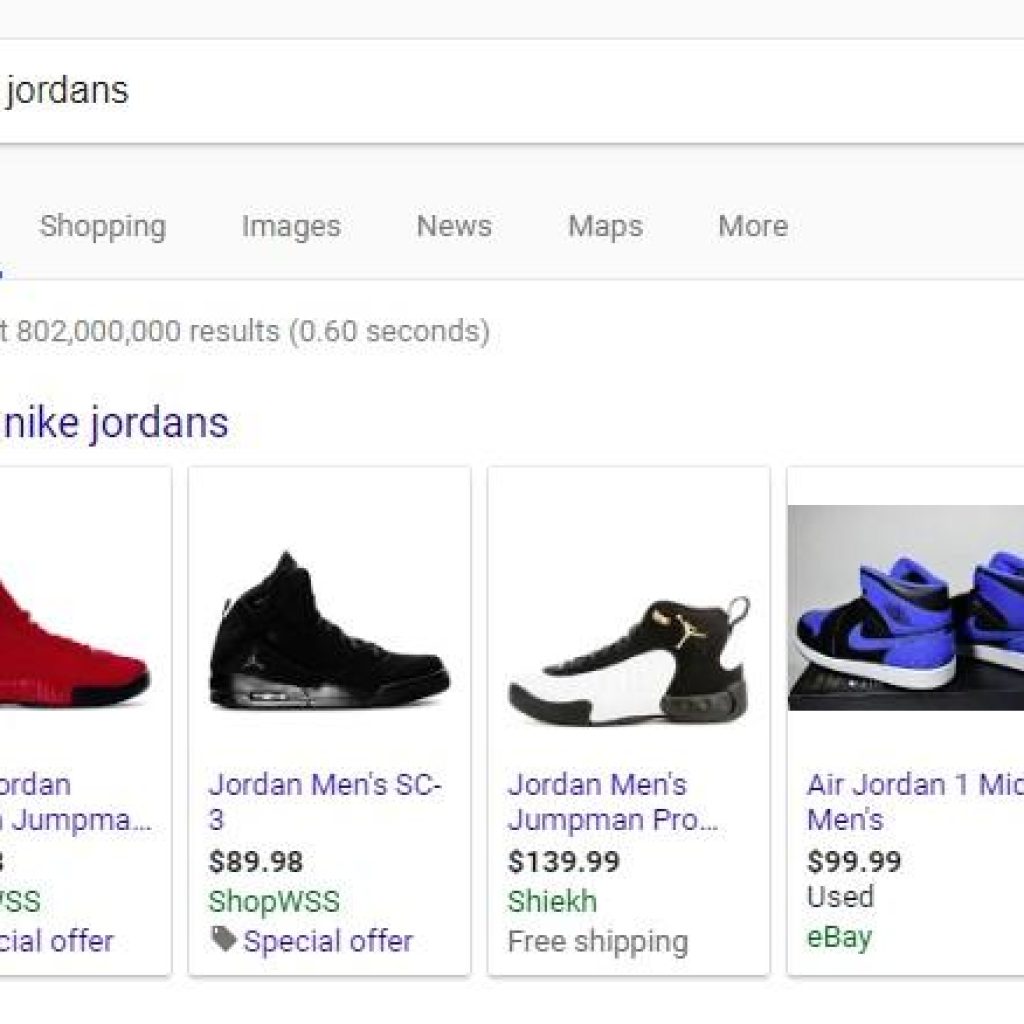
Three different kinds of shopping campaigns exist:
- Product shopping advertisement.
- Shopper’s ad on display.
- Shopping ad for local inventory.
Guidelines for Google Shopping ads
The recommended methods for using Google Shopping ads to increase sales are listed below.
- Your product information should be full of keywords.
To determine whether your products match a potential customer’s search query, Google will use the product data you provide. Therefore, use keywords that best describe your products and included them in product titles and descriptions.
- Always check your product information twice.
Google will only display your product ads if your prices are accurate, especially if you use various foreign currencies. Therefore, ensure your procedure for updating availability, pricing, and product information are impenetrable. You can manually check your product information using Google spreadsheets, for instance. However, it might be a better idea to look for specialized software if you have a large number of products. You’ll save time and guarantee the accuracy of your product data feed in this way.
- Use only top-notch pictures
Take good care of your product images because they could play a significant role in the success of your advertising campaign. Therefore, they must be of excellent quality and against a transparent background.
5. App advertising campaigns
It boost your app downloads. Do you have a mobile app for your company? You can advertise your app using Google Ads on all of Google’s major websites, including Google Play, YouTube, Search, and the Google Display Network.
Producing ads to encourage users to download your app or perform a particular action therein.For App campaigns, you don’t need to create individual ads like you would for other Google Ads ad types. Instead, your ads are created for you automatically! Please include some text, a starting offer, a spending limit, as well as the languages and regions where your campaign will run. Additionally, if HTML5 assets apply to your company, you can add them. Google Ads will then modify the information for various ads across different networks and formats.
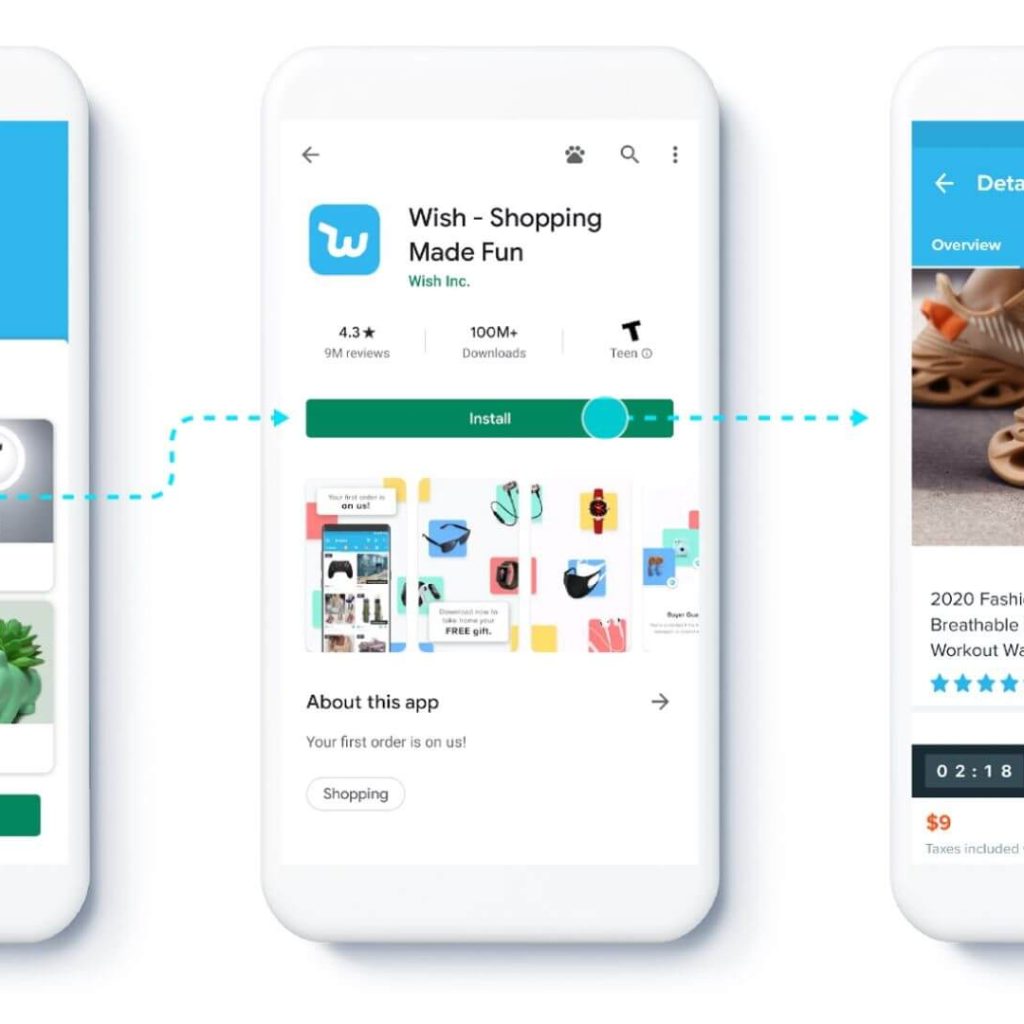
Ad campaigns for Google Apps:
Google App campaign best practices to help you reach more potential customers.
- Allow Google time to improve your ads.
If it is not producing the results you had hoped for, you may want to change the budget or stop the advertisement. However, if your advertisements have only been running for a few days, wait before making any decisions. Before you make any decisions, give Google Ads at least seven days to run your campaign and optimize your ad creatives, placements, and bids. If changes are necessary, make sure they are minimal enough to avoid wiping out Google’s machine learning.
- Add a variety of resources
Google suggests including a minimum of one each of a landscape photo, a portrait video, and a landscape video. After testing various asset combinations, they will then run the ads that are performing the best more frequently.
Google Ads best practices for maximum results
Now that we are familiar with the various types of Google ads, let’s move on to the best practices for the best outcomes.
These procedures aid in Google ad optimization. Reviewing your account data and making adjustments to ensure optimal performance is known as “Google Ads optimization. The settings build and tests that supported optimal performance last month (or even last week) may be working against optimal performance due to how quickly the digital marketing environment changes. For instance, one of your initial keywords might have done exceptionally well in the first month, but when you look at your data, you notice that it’s now increasing your cost-per-conversion from the second month (CPA). You pause that keyword as part of your optimization strategy so your account can concentrate more on other keywords with lower CPAs. You learn more about the unintended consequences of your current settings, keywords, etc., on your account during the optimization phase.
1. Using research and PPC spy tools
Increase expansion opportunities. Performing keyword research can be time-consuming. But carrying out your due diligence can be beneficial, and thanks to the tools we have today, it’s easier than you might think. It’s time to look into ways to grow if your account is at a standstill.
2. Utilize SKAGs to exert more control.
How can you best take complete control of your Google Ads campaigns? SKAGs (Single Keyword Ad Groups) (opens in a new tab). You choose one keyword for each ad group in your campaign and create a set of ads with that keyword appearing at least once in the headline.
3. Feed your funnel with prospecting display advertisements.
Yes, we advise you to spend money on display ads, a top-of-funnel medium that is more likely to increase awareness and exposure than conversions. Targeting techniques include affinity targeting, similar-to targeting, custom audience targeting, and in-market list targeting. That’s because you’ll build a healthier account by considering your sales funnel as a whole rather than just the bottom.
4. For your primary business objective, pay attention to metrics and KPIs.
So many of us become fixated on micro metrics and ignore the bigger picture. Avoid falling into this trap and becoming fixated on minute details such as quality score, impression share, CTR, CPC, etc. These metrics are significant, to be sure, but if they aren’t contributing to your primary business objective—a sale—then they aren’t doing much to inform you of the actual status of your PPC campaigns.
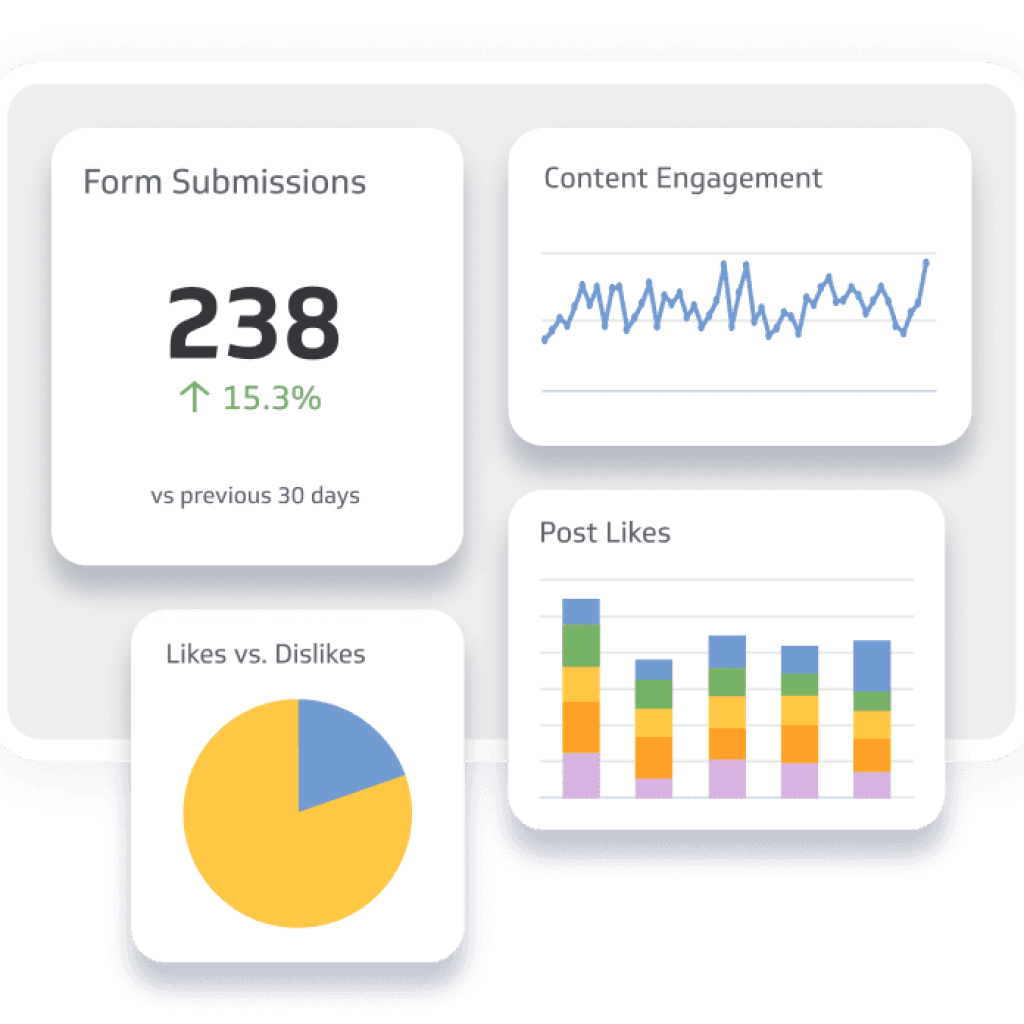
5. Spend money using geolocation where people are buying.
You cannot expect them to perform consistently across your campaigns if you are targeting the US or a sizable group of nations or cities. So the best course of action is sometimes to leave your locations as they are just because that’s where you want your ads to appear or because you want to widen the net you’re casting.
6. Improve and add to your keyword list.
Let’s face it; the keyword list may no longer be applicable. The data is crucial, regardless of how positive you may feel about the initial keywords. Once you’ve used those keywords for some time in your advertising, you should consider improving them. Examine and identify each of your keyword areas. You may have three well-performing keywords with low CPAs and many conversions.
7. Keep optimizing and testing your ads.
Ad testing is one of the best ways to ensure you’re constantly improving your game. You will eventually have a stale copy if you continuously run the same advertisements. Perhaps those advertisements have been successful for you, and you don’t see the need to change them. This is what happens. So you need to keep optimizing your ads even though they are currently performing well.
Also Read: 10 Benefits of SEO for Your Business
Final thought
Any e-commerce company willing to learn how to market to Google’s enormous user base based on search intent and a variety of other targeting options and placements will benefit from using the Google Ads platform. You should now know better what is possible on the Google Ads platform, what to anticipate from the various campaign types available, and how they can interact with the rest of your marketing engine. Google Ads optimizations play a significant role in this as well. You can’t anticipate your account growing. And if you can’t count on your account to expand, you’ll have to watch as your rivals overtake you. Your outstanding account performance will demonstrate how much better a marketer you become by staying ahead of your account and its many fluctuations.















